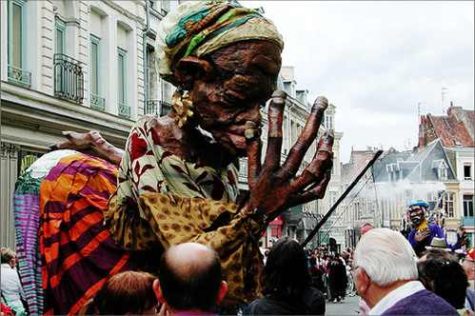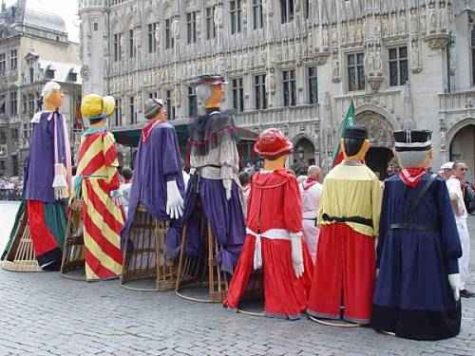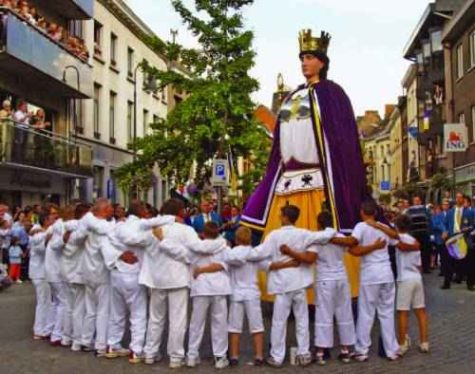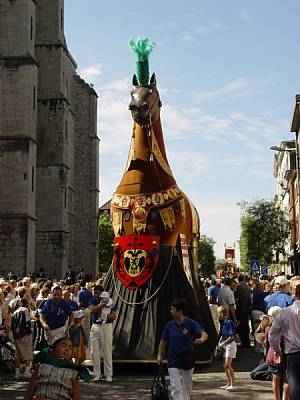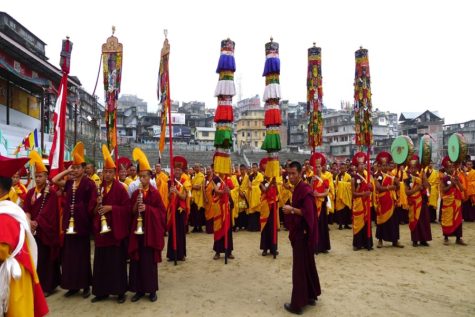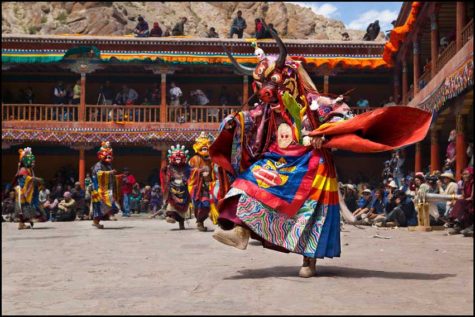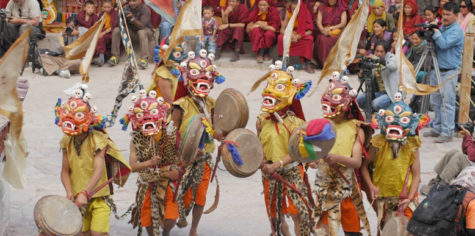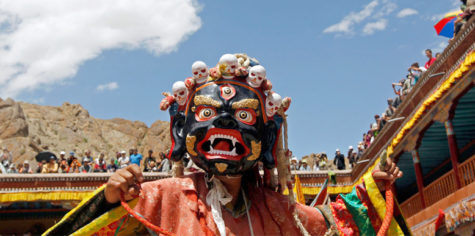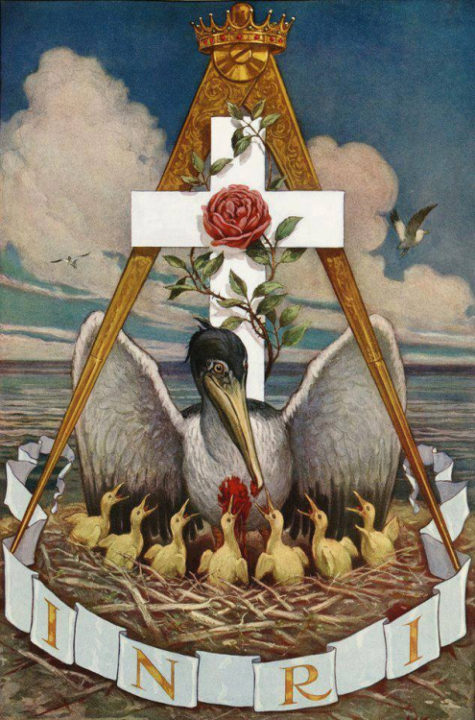July
Knut the Reaper is possibly the original Grim Reaper, complete with the appearance of a skeleton clad in dark flowing robes wielding a scythe. In Norse mythology he enjoys commemoration on July 10 with the goddesses (Hel or Hela, Holda and Skadi) of the shades and underworlds Helheim and Niflheim.
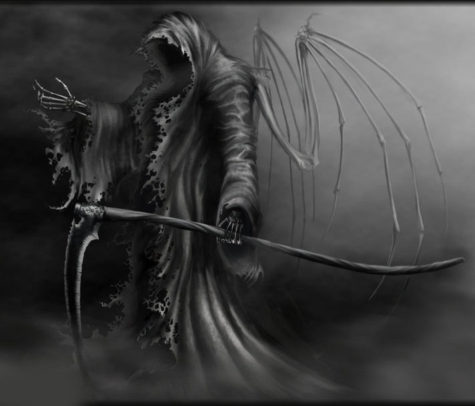
Day of Knut the Reaper (July 10) is a centuries-old festival in which Wickerwork giants are paraded through the city streets of Douai, France to drive away evil spirits.
Traditional processions of huge effigies of giants, animals or dragons encompass an original ensemble of festive popular manifestations and ritual representations. These effigies first appeared in urban religious processions at the end of the fourteenth century in many European towns and continue to serve as emblems of identity for certain Belgian (Ath, Brussels, Dendermonde, Mechelen and Mons) and French towns (Cassel, Douai, Pézenas and Tarascon), where they remain living traditions.
The giants and dragons are large-scale models measuring up to nine metres in height and weighing as much as 350 kilos. They represent mythical heroes or animals, contemporary local figures, historical, biblical or legendary characters or trades. St. George fighting the dragon is staged in Mons; Bayard, the horse from the Charlemagne legend, parades in Dendermonde; and Reuze Papa and Reuze Maman, popular family characters, parade at Cassel.
The performances, often mixing secular procession and religious ceremony, vary from town to town, but always follow a precise ritual in which the giants relate to the history, legend or life of the town.
July 10th is Lady Godiva Day. I’m sure we’re all familiar with the story – but here it is again:
The Countess Godiva devoutly anxious to free the city of Coventry from a grievous and base thralldom often besought the Count, her husband, that he would for love of the Holy Trinity and the sacred Mother of God liberate it from such servitude. But he rebuked her for vainly demanding a thing so injurious to himself and forbade her to move further therin.
Yet she, out of her womanly pertinacity, continued to press the matter insomuch that she obtained this answer from him: “Ascend,” he said, “thy horse naked and pass thus through the city from one end to the other in sight of the people and on thy return thou shalt obtain thy request.”
Upon which she returned: “And should I be willing to do this, wilt thou give me leave?”
“I will,” he responded.
Then the Countess Godiva, beloved of God, ascended her horse, naked, loosing her long hair which clothed her entire body except her snow white legs, and having performed the journey, seen by none, returned with joy to her husband who, regarding it as a miracle, thereupon granted Coventry a Charter, confirming it with his seal.
From the Flores Historiarum by Roger of Wendover
Celebrated by the residents of Nunavut, Canada, on July 9 each year, Nunavut is a time to honor the efforts of those who helped to bring this territory into being. For many years, the Inuit had worked toward forming their own territory. On July 9, 1993, the Nunavut Land Claims Agreement Act took effect, and Nunavut was established on April 1, 1999. Nunavut Day was declared an official government holiday in 2001.
The day is traditionally celebrated with live music, barbecues, the wearing of traditional dress, traditional foods are served, and the community sponsors activities such as concerts, craft fairs, and contests, including seal skinning and duck plucking.
From: Almanac.com
Poplifugia was a Roman festival on July 5. It means “flight of the people.” The origin of Poplifugia is not known. Two explanations are given by H.H. Scullard:
- the people fled when Romulus disappeared from mortal sight during a tempest
- the flight of the Roman people after the sack of Rome by the Gauls
There doesn’t seem to be much information about this festival. It took a fair amount of digging, but I was able to come up with a little something more about the Poplifugia. Here’s what I found:
The Festivals of the Poplifugia and the commemoration of Romulus are celebrated on July 5 and July 7, respectively. These two festivals are thought to be a continuation of the same festival, as it was customary for the Romans to have festivals that ran on several days but skipped the even-numbered days because they were considered ill-omened in Rome.
There was also a Rumilia festival that might have been celebrated at the same time.
Although much has been written on this topic, it is not well understood, because the Romans had an extremely conservative religion, in which they continued to do rituals, but they did not remember what they were for, and much of the information about their religion has been lost or deliberately destroyed.
The Poplifugia was a ritual in which someone was chased out of the Regia, or “King’s House”, actually the formal residence of the Sacred King of Rome.
This early July date corresponds approximately to the time of slaughter of livestock in Mediterranean countries which have a dry season during most of the summer during which there is no fodder for cattle.
Its name which is interpreted to mean, “The Flight of the People”, may refer to the sacking of Rome by the Gauls in 390 BC. However, it is impossible not to notice that the word popli- in Poplifugia, and which is interpreted as meaning `people’ is very similar to the word popa which is the Latin word for the attendant who actually slaughtered the animals at a sacrifice, that is, it was the job of the popa to hit the animal in the forehead with an ax which stunned it. Someone else cut the animal’s throat so that it bled to death, and the whole operation was organized by a priest who spoke the religious formulas and directed everyone on what they should do.
If the festival was originally called a *Popafugia (“fleeing of the popa or axeman”), it would be even more completely in line with the Bouphonia, as it was performed in classical Greece. Nevertheless, the connection has been made between the Poplifugia and the Greek Bouphonia and both are thought to embody the myth of the killing of the first cow, which makes up the Indo-European creation myth, known as the Primal Cow Creation Myth.
Found at: Associated Content
A great recipe to celebrate Independence Day in the United States:
- ¾ cup sour cream
- 1/4 tsp. coarse black pepper
- 1 tsp. white sugar
- 1 tbsp. rice wine vinegar
- 1 tsp. fresh chopped dill
- 1/8 tsp. fresh grated lemon peel
- 1/4 tsp. finely grated red onion
- salt
- 1 cucumber
- 3 garden fresh red tomatoes
- 10 borage flowers
Combine all the ingredients except for the tomatoes and flowers. Slice tomatoes and arrange them, overlapping, around the edge of a serving platter. Mound the cucumber mixture in the center of the platter, just covering the inner edge of the tomatoes. Chill well, and place the borage flowers decoratively on the salad just before serving.
Serves 4 to 6
Recipe by Di-Di Hoffman
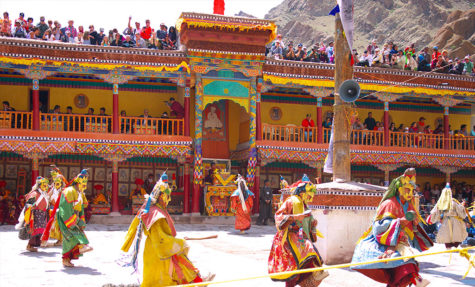
After a tough winter the chills have become bearable, the Hemis monastery opens its doors to enjoy festivities. The date every year changes as it is celebrated every year on the tenth day of the Lunar calendar of the Tibetan month. The dates for this festival vary from year to year. in 2017 it falls on July 3 and 4.
The festival highlight is the Dance performances and plays by masked Lamas. The masked dance represents the good prevailing over evil. The participants of the spellbinding performance are dressed in vibrant costumes and bright masks. Every mask has its own place in Tibetan and Buddhist legends. Signifying aspects of good and evil, they are designed as humble, divine faces, animals, skeletons and numerous frightful figurines. Dancers can be seen with slow dance movements and fanciful expressions.
The masked dance performance is created on music medley of sounds of drums, trumpets and cymbals. The famous Padmasambhava dance, the highlight of the dance shows the victory of the ruta demons. The dances are spellbinding as the divine is represented and its said to be purifying your soul.
Here are some video clips:
Origins
Based on Tibetan and Buddhist Legends, Hemis Festival is said to have its origins back in 8th Century. Lord Padmasambhava also known as Guru Rimpoche is believed to be the local savior who banished demons and evil spirits. The spiritual leader is said to have introduced of Tantric Buddhism in the Himalayan Kingdom. Combining the teachings of Buddhism and Tibetan culture, a new way was established where life was entwined with prayers, austere life and a higher calling.The birth of Guru Rimpoche also known as Lord Padmasambhava is the occasion which is celebrated during Hemis Festival. The spiritual leader is conferred as the local savior.
Celebrations
The mask dance performance is the main attraction of the Hemis Festival
Ever seen Lamas dance? Well here they do, in their tell tale burgundy and mustard yellow attires. The old and the young gather to partake and witness this performance, the re-telling of their ancient mythological stories and folklore. The real spectacle is provided by the masked performers wearing horns, multicolored ribbons and brocade clothes that shine in the bright July sun. And believe me, some of those masks are more expressive than us.
The Chams are a part of the Tantric tradition performed to a cacophony of indigenous musical instruments. The music starts on a slow note and quickly picks up pace as the narrative becomes intense. It keeps building up to a hair raising climax when the leader of the Black Hat dance strikes down the devils idols (made of dough) in combat victory. The message is one that been around for eternity, that good prevails over evil. Its execution through the masked dance performance is what takes your breath away.
Every 12th year known as the Tibetan Year of the Monkey, Hemis Monastery Festival takes an auspicious turn.The unfurling of the largest Thangkha (12 metres) from the second floor of the monastery for the world to see happened in 2016, and won’t happen again for another 12 years. The scripture is worth seeing as it’s so delicately preserved.
Inside the monastery and outside during the festival check out the stalls. From delightful tastes of the mountain Kingdom to unique handicrafts of the region the sight are wonderful. Residents of remote villages, adventure seekers, photographers and travelers make their way here to be a part of the festival.
Other Ways To Celebrate:
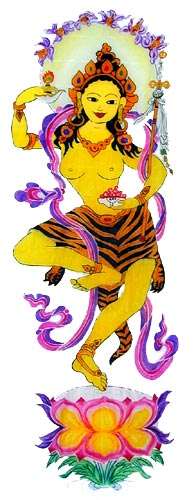 I have been enjoying the book, 365 Goddess. In this book, the author explores a different goddess every day in the context of rituals, feast days, holidays, festivals, and celebrations from around the world. Today is the celebration is the Hemis festival.
I have been enjoying the book, 365 Goddess. In this book, the author explores a different goddess every day in the context of rituals, feast days, holidays, festivals, and celebrations from around the world. Today is the celebration is the Hemis festival.
This festival includes a ritual play in which all manner of mythic creatures are poised against the Tibetan lamas, symbolizing the battle between good and evil. bells, censers, cymbals, and drums draw in positive magic, banish evil, and win the fight for goodness.
The goddesses assigned for this day are the Ratna Dakinis. In Tibet, these goddesses rule over all gestures of goodness and compassion, which naturally help improve karma. Collectively, their names mean “inestimable,” showing us the true power and value in acts of kindness that are driven by a pure heart.
The book also includes ideas for simple magical rituals and/or easy spells that are in keeping with the theme for the day. And so we find that for the Hemis festival the themes are the: banishing; victory; kindness; karma, and the color yellow.
For today, the suggestions are to wear something yellow, and also try to keep the Ratna Dakinis in mind so that your actions will be gentle and filled with kindness. You could also, using yellow ribbons, string together a collection of small bells for a Ratna Dakinis house amulet. Hold these in your hand and empower them by saying:
Let your goodness ring, let purity sing,
with each wind Ratna Dakinis’ blessing bring!
Hang these where they will catch the wind regularly, releasing the magic.
Other ideas include the following:
Do something nice for someone who’s been feeling blue lately, “just because”. Give them some yellow flowers, offer a hug, or maybe make an extra bell amulet for them too! This boosts good karma, makes both of you feel good, and invokes Ratna Dakinis’ blessings through thoughtfulness.
Note: This post was put together by Shirley Twofeathers, you may repost and share it only if you give me credit and a link back to this website. Blessed be.
July 3 is Rosa Mundi or Rose of the World day in the Palestinian Christian Calendar.
This day has its roots in Rosicrucian mythology (a 17th century secret society rooted in Christian mysticism that has influenced many aspects of modern life including Freemasonry.
Esoterically, the Rose is a symbol of wisdom and knowledge with the Rose of the World as a synonym for Pax Cultura, peace through culture. Daniil Andreev, the Russian mystic and poet, saw Rose of the World as a sign of the future age of Mother of the World, a New spiritual and idealized Age of Aquarius.
So now, when you look at a red rose you can see it as a meditation on an ideal new age to come and the dream of world peace and a new awakening.
Because the warm weather continues, activity levels are high, even though the days are beginning to shorten. Consequently, numerous festivals during this month focus on family, friends, and social interaction.
For magical purposes, July directs our attention to personal growth and improvements. This includes increasing your knowledge, continuing efforts for prosperity, creating new ideas and works of art, and also taking time out periodically to really enjoy yourself. Our society sometimes mistakes much-needed leisure time for laziness but this months’s energies know better. Go and have fun, carrying the Goddess with you for a little extra energy.
July Correspondences:
- Nature Spirits: hobgoblins (small grotesque but friendly brownie-type creatures), faeries of harvested crops.
- Herbs: honeysuckle, agrimony, lemon balm, hyssop
- Colors: silver, blue-gray
- Flowers: lotus, water lily, jasmine
- Scents: orris, frankincense
- Stones: pearl, moonstone, white agate
- Trees: oak, acacia ash
- Animals: crab, turtle, dolphin, whale
- Birds: starling, ibis, swallow
- Deities: Khepera, Athene, Juno, Hel, Holda, Cerridwen, Nephtys, Venus
Power flow:
Relaxed energy; preparing, succeeding. Dream work; divination and meditation on goals and plans, especially spiritual ones.
July Festivities:
At first the Romans called this month Quintilis, but later renamed it Julius after Julius Caesar, who was born in this summer month. The Greek Olympian was held for about a week in July. This festival in honor of Zeus consisted of competitions in athletics, drama, music, and other activities. During the time of the Olympian, all participants were given safe-conduct to and from the games. The constant petty Greek squabbles were put aside. A victory in the Olympian was a great achievement, both for the individual and for their city.
Two of the Roman holidays held during this month were July 8 – 9 when the Goddess Juno was honored and the Neptunalia on July 23, when Neptune, the god of the seas and earthquakes, was placated.
In Japan, the Full Moon of July saw the O-Bon, or Festival of Lanterns. This was a combination of Buddhist and Shinto beliefs that honored the dead. Homes, tombs, and ancestral tablets were thoroughly cleaned. Altars and shrines were decorated. The gardens were hung with lanterns to light the way of the dead so that they could join with their families for the three-day ceremony.
The Egyptian New Year fell in July, as did the Opet Festival, which commemorated the marriage of Isis and Osiris. Their sexual union was said to bring good luck to all people. About the same time in Rome, the love of Venus and Adonis was celebrated. The Egyptian year was measured against the Nile and its yearly fertile floods. This was also the time of the birth of Isis and Nephthys, Osiris, Set, and Haroeris. These days were the ones won by Thoth for these deities; births; in other words, there were the necessary days to make the solar and lunar calendars match.
The Incas had a ceremony called Chahua-huarquiz, Chacra Ricuichi, or Chacra Cona, which meant Plowing Month. While the Northern Hemisphere was beginning its agricultural harvests with the reaping of the corn crop, the Southern Hemisphere was just beginning to break ground for planting.
Buddha’s Birth and Preaching, also called the Picture Feast, was celebrated in Tibet.
From: Moon Magic and 365 Goddess
July 1st is Canada Day, a holiday that marks Canada’s independence from Great Britain which took place in 1982.
There is no standard mode of celebration for Canada Day; Jennifer Welsh, a professor of International Relations at the University of Oxford, said about this: “Canada Day, like the country, is endlessly decentralized. There doesn’t seem to be a central recipe for how to celebrate it—chalk it up to the nature of the federation.
Most communities across the country will host organized celebrations for Canada Day, typically outdoor public events, such as parades, carnivals, festivals, barbecues, air and maritime shows, fireworks, and free musical concerts, as well as citizenship ceremonies.
However, the locus of the celebrations is the national capital, Ottawa, Ontario, where large concerts and cultural displays are held on Parliament Hill, with the governor general and prime minister typically officiating, though the monarch or another member of the Royal Family may also attend or take the governor general’s place.
Source: Wikipedia
What follows is a list (in alphabetical order) of the names given to the July moon. Also listed is the tradition and/or origin of that moon name:
Blackberry Moon ~other
Little Ripening Moon ~Creek
Blessing Moon ~Dark Janic
Blood Moon ~other
Buck Moon ~Algonquin
Buffalo Bellow Moon ~Omaha, Arapaho
Claiming Moon ~Celtic, Janic (full)
Corn Popping Moon ~Winnebago
Crane Moon ~Choctaw
Dropping Deer Horns Moon ~Kiowa
Ducks Moult Moon ~Cree
Fallow Moon ~other
Grain Moon ~other
Grass Cutter Moon ~Abernaki
Hay Moon ~Cherokee, Algonquin
Horse Moon ~Apache
Hungry Ghost Moon ~Chinese
Little Harvest Moon ~Creek
Little Ripening Moon ~Creek
Mead Moon ~Medieval English
Meadow Moon ~other
Middle Summer Moon ~Ponca, Dakota
Peaches Moon ~Natchez
Raptor Moon ~Hopi
Raspberry Moon ~Anishnaabe
Red Berries moon ~Assiniboine
Ripe Corn Moon ~Cherokee
Ripe Moon ~San Juan, Apache
Ripe Squash Moon ~Agonquin
Ripening Moon ~Mohawk, Passamaquoddy
Rose Moon ~Neo Pagan
Salmon River Moon ~Wishram
Smoky Moon ~Maidu
Summer Moon ~Colonial American, Algonquin
Sun House Moon ~Taos Native American
Thunder Moon ~Algonquin
Wild Red Cherries Moon ~Sioux
Wort Moon ~other
Young Corn Moon ~Potawatomi
